咨询方法与工具资料库QPWORK【精品文档】
- 格式:doc
- 大小:25.50 KB
- 文档页数:10

Area Function Event Scenario for Oscar1. Patient Admission1.1. Determine Admission Type, Provider Type, and Identify Patient1.1.1. Enter Patient Search Criteria1.1.1.1. First Name, Last Name, Date of Birth, Social Security Number. See Issues1.1.2. Patient Exists in Patient Table - more than one patient returned1.1.2.1.1.System - Display result set, allow user to select desired patient1.1.3. Patient Exists in Patient Table - exactly one patient returned1.1.3.1.1.System - Retrieve patient information1.1.3.1.2.System - Verify required information (Admit Type, Provider Type, Signin-Time)1.1.3.1.3.System - Proceed to the Confirm Patient Demographics window1.1.4. Patient Does Not Exist in Patient Table1.1.4.1.1.System - Verify required information (Admit Type, Provider Type, Signin-Time)1.1.4.1.2.System - Confirm user response to enter new patient1.1.4.1.2.1.If YES, then store the patient information, proceed to the Patient Demographics window1.1.4.1.2.2.If NO, then remain on the Patient Search window and allow user to modify patient search criteria1.1.5. Continue Patient Admission Process (OK)1.1.5.1.1.System - Verify required information (Admit Type, Provider Type, Signin-Time)1.1.5.1.2.System - If Admit Type IS NOT Private, then store patient information, proceed to the Confirm Patient Demographics window1.1.5.1.3.System - If Admit Type IS Private, then proceed to the Private Practice Admission window1.1.6. Cancel Patient Admission Process (Cancel Admit)1.1.6.1.1.System - Confirm user response to Cancel Patient Admission process1.1.6.1.1.1.If YES, then discard all collected information, and return to the Main Menu1.1.6.1.1.2.If NO, then remain on the Patient Search window1.2. IF ADMIT TYPE IS W/C NEW INJURY1.3. Confirm Patient Demographics Window1.3.1. Modify Patient Demographic Information (Modify Demographics)1.3.1.1.1.System - Proceed to the New/Modify Patient Demographics windowArea Function Event Scenario for Oscar1.3.2. Continue Patient Admission Process (OK)1.3.2.1.1.System - Proceed to the Confirm Employer Demographics window1.3.3. Cancel Patient Admission Process (Cancel Admit)1.3.3.1.1.System - Confirm user response to Cancel Patient Admission process1.3.3.1.1.1.If YES, then discard all collected information, and return to the Main Menu1.3.3.1.1.2.If NO, then remain on the Confirm Patient Demographics window1.3.4. Returned from Confirm Employer Demographics Window1.3.4.1.1.System - Display updated patient demographic information1.4. Confirm Employer Demographics Window1.4.1. Enter Employer Demographics Information1.4.1.1. Hire Date1.4.2. Modify Case Employer (Select Employer)1.4.2.1.1.System - Store entered information1.4.2.1.2.System - Proceed to the Employer Search window1.4.3. Modify Occupation (Select Occupations)1.4.3.1.1.System - Store entered information1.4.3.1.2.System - Proceed to the Select Occupation window1.4.4. Return to Confirm Patient Demographics Window (Previous)1.4.4.1.1.System - Store entered information1.4.4.1.2.System - Return back to the Confirm Patient Demographics window1.4.5. Continue Patient Admission Process (OK)1.4.5.1.1.System - Verify required information. See Issues1.4.5.1.2.System - Store entered information1.4.5.1.3.System - Proceed to the New Injury window1.4.6. Cancel Patient Admission Process (Cancel Admit)1.4.6.1.1.System - Confirm user response to Cancel Patient Admission process1.4.6.1.1.1.If YES, then discard all collected information, and return to the Main Menu1.4.6.1.1.2.If NO, then remain on the Confirm Employer Demographics window1.4.7. Returned from New Injury Window1.4.7.1.1.System - Display employer demographic information previously enteredArea Function Event Scenario for Oscar1.5. New Injury Window1.5.1. Enter New Injury Information1.5.1.1. Date of Injury, Time of Injury, Location, PO Number, Authorization, Injury Area, Patient Description1.5.2. Return to Confirm Employer Demographics Window (Previous)1.5.2.1.1.System - Store entered information1.5.2.1.2.System - Return back to the Confirm Employer Demographics window1.5.3. Continue Patient Admission Process (OK)1.5.3.1.1.System - Store entered information1.5.3.1.2.System - Verify required information (Date of Injury, Time of Injury, Authorization, Injury Area)1.5.3.1.3.System - Validate Date of Injury (Not to allow future injury date)1.5.3.1.4.System - If Provider Type is Physician then proceed to the Pre-Defined Injury Protocols window1.5.3.1.5.System - If Provider Type is Specialist then proceed to the Referring Specialist window1.5.3.1.6.System - If Provider Type is Therapist then proceed to the New Therapy Notes window1.5.4. Cancel Patient Admission Process (Cancel Admit)1.5.4.1.1.System - Confirm user response to Cancel Patient Admission process1.5.4.1.1.1.If YES, then discard all collected information, and return to the Main Menu1.5.4.1.1.2.If NO, then remain on the New Injury window1.5.5. If Specialist - Returned from Referring Specialist Window1.5.5.1.1.System - Display new injury information previously entered1.5.6. If Therapist - Returned from New Therapy Notes Window1.5.6.1.1.System - Display new injury information previously entered1.5.7. If Physician - Returned from Pre-Defined Injury Protocols Window1.5.7.1.1.System - Display new injury information previously entered1.6. If Specialist - Referring Specialist Window1.6.1. Enter Referring Specialist Information1.6.1.1. Referring Specialist1.6.2. Return to New Injury Window (Previous)1.6.2.1.1.System - Store entered information1.6.2.1.2.System - Return back to the New Injury window。
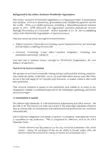
Background to the Arthur Andersen Worldwide OrganisationThe Arthur Andersen Worldwide Organisation is a leading provider of professional and advisory services to businesses, governments and multilateral agencies around the world. With over 62,000 personnel, including a telecommunications industry group of over 2,700 personnel, the organisation provides professional services through 318 locations in 72 countries. Arthur Andersen & Co. SC, the co-ordinating entity of the Worldwide Organisation, is based in Geneva.Our firm serves its clients through two business units:∙Arthur Andersen, which offers accounting, audit, business advisory, tax and legal and speciality consulting services; and∙Andersen Consulting, which offers business integration consulting and information technology solutions.Our firm has a common culture through its Worldwide Organisation, the core features of which are:One level of service worldwideWe operate as one firm worldwide, sharing human, technical and training resources. Our clients are clients of the firm, not of one particular office, and as such, they have access to the full range of our expertise and resources, no matter where in the world they need them.This one-firm structure is unique in our profession, and enables us to bring to any assignment a tightly co-ordinated approach to the information gathering, assessment and report stages.A commitment to qualityWe enforce high standards, in both professional achievement and client service. We are able to do this because we train our people to the same high standards wherever they are based and our expectations and measurement of performance are consistent internationally.Our worldwide integration and ability to deliver co-ordinated, multinational service is unrivalled in our profession. This is recognised by observers such as the UK’s Financial Times.“Arthur Andersen has long stood out as the only worldwide partnership with central control. Among the advantages of this are the ability to transfer people, skills and services around the world and the sharing of research and development costs”.Arthur Andersen's European Telecommunications PracticeThe telecommunications industry is one of the ten strategic industries for which the Arthur Andersen Worldwide Organisation has a specialist industry team. The team, which has developed over the last two decades, now has over 2,700 personnel, of which approximately 900 work in Europe. Its strength and depth ensures it has the resources to undertake significant projects of great complexity.The considerable experience of the international telecommunications team is disseminated through training and industry seminars. The firm has a range of training courses specifically tailored to the needs of its telecommunications specialists. In addition, the European team which is coordinated out of London meet on a regular basis to develop the practice and to update themselves on the latest trends.The one firm structure of Arthur Andersen enables us to deploy the best resources to any telecommunications assignment regardless of location. The considerable expertise of our london based telecommunications professionals means that they are often asked to support local teams to ensure that the full knowledge of the industry team is brought to bear.Services to the Telecommunications IndustryArthur Andersen acts as consultants to telecommunications companies worldwide and has in-depth knowledge of the issues shaping the industry. In addition to acting as financial auditors to telcos in countries including the UK, US, Argentina, Italy, Spain, Portugal, Lithuania and Greece, our telecoms practice is focused on the following key service lines:∙TaxationOur tax practice provides advice on a wide range of taxation areas and issues such as taxation planning and corporate tax structuring, corporation tax compliance, personal and expatriate taxes, indirect taxes (VAT), and international taxation.∙Cost accountingAccurate cost information is vital for telecommunications companies, particularly for product management, strategic planning and setting the price floor for a service. We have considerable skills in determining and analysing cost of service information. We have advised clients on regulated versus non-regulated costing, service costing and transfer pricing.。

Page 1Reprinted from "ABCD Checklist"TABLE OF CONTENTSPage EXECUTIVE SUMMARY3OVERVIEW QUESTIONS10 I. Planning and Control Processes11 II. Data Management14 III. Continuous Improvement Processes15 IV. Performance Measurements16 V. Overview Question Summary18AUDIT QUESTIONS21 I. Planning and Control Processes22 A. Strategic Planning22 B. Business Planning24 C. Sales & Operations Planning25 D. Financial Planning, Reporting and Measurements 28Page 2Reprinted from "ABCD Checklist"E. “What if?” Simulations30 F Demand Management-Forecasting, Sales Planning andOrder Entry and Promising31 G. Master Production Scheduling34 H. Supplier/Purchasing Management37 I. Material Planning and Material Control39 J. Capacity Planning and Capacity Control43 K. New Product/Engineered Product Planning andControl.44 II. Data Management46 III. Continuous Improvement Processes48 A. Education and Training48 B. Continuous Improvement52 IV. Performance Measurements59 V. Audit Questions Summary65 APPENDIX 67EXECUTIVE SUMMARYIntroduction to the ABCD checklist The following report is an ABCD checklist audit of Hypro Corporation. TheABCD checklist was developed by The Oliver Wight Company for use asan evaluation tool to measure the effectiveness of a manufacturingcompany's abilities to plan and control their business operations.The ABCD checklist is an audit tool which focuses not only on themanufacturing operations , but the company as a whole. All functionalareas within the company are evaluated for a high level of integrationwith the company's objectives and an ability to deliver excellent customerservice. Strong emphasis is placed on the subjects of business planning,manufacturing strategy, sales and operations planning, and continuousimprovement.Page 3Reprinted from "ABCD Checklist"。
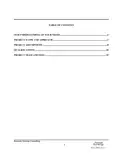
TABLE OF CONTENTSOUR UNDERSTANDING OF YOUR NEEDS (2)PROJECT SCOPE AND APPROACH (3)PROJECT ASSUMPTIONS (8)QUALIFICATIONS (10)PROJECT TEAM AND FEES (15)Our Understanding of Your NeedsBased on our meeting and subsequent telephone conversations, ourunderstanding of your current environment is as follows:❑People, headquartered in New York, has additional fieldlocations in Chicago, Houston, Los Angeles, Washington D.C.,and London.❑The New York headquarters has approximately 200 personnel.The largest field location is Los Angeles with approximately12-18 personnel. All other satellite offices have staff levelsranging from 2-12 personnel. Freelance writers andphotographers are also utilized on an as needed basis.❑People is currently in the early phases of their InformationSystems Plan. One of the projects currently in progressincludes an in-depth software analysis and selection project.The technology staff is currently comparing Quark’s QPSoffering with Seitex’s P.Ink offering. The final selection willreplace People’s current ATEX software.❑ATEX was historically People’s core business sytem. It wasutilized for story editing as well as the layout of the magazine.In addition, ATEX provided People with a vehicle formessaging and communications.❑As part of People’s Information Systems Plan, the division hascommitted to the use of Lotus Notes.Project Scope and ApproachBased on our discussions and our experience with systems designand implementation, we recommend a phased approach as follows:Phase I:Design and Develop Pilot Application(s)Phase II:Implement Pilot Application(s)Phase III: Develop and Implement AdditionalFunctionality/ApplicationsPhase IV: Design Enterprise-wide InfrastructurePhase V:Implement Enterprise-wide InfrastructurePhase VI: Monitor and Enhance Existing Applications / Identifyand Develop Additional applicationsThe diagram below graphically depicts the various phases of theoverall project with some phases occurring simultaneously.TIME LINE。
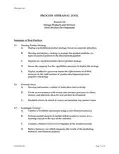
PROCESS APPRAISAL TOOLProcess 3.0Design Products and Services(New Product Development)Summary of Best Practices3.1 Develop Product StrategyA. Deploy a well-defined product strategy, based on corporate objectives.B. Develop and deploy a strategy to manage the product portfolio, i.e.,types of product projects in the development pipeline.C. Implement a market/customer-driven product strategy.D. Insure the company has the capabilities necessary to deploy the strategy.E. Deploy an effective process to match the right number of skilledresources to the right number of product development projects(pipeline balancing).3.2 Generate IdeasA. Develop and nurture a culture of innovation and creativity.B. Create an environment with formal and informal processes to collect,nurture, and stimulate ideas for new product development.C. Establish criteria by which to screen and prioritize new product ideas.3.3 Investigate ConceptA. Conduct a feasibility assessment using a cross functional process.B. Perform market analysis to further define product to ensure it is awinning concept in the eyes of the customer.C. Conduct a detailed technical investigation of the product concept.D. Build a business case which integrates the results of the marketing,technical, and financial analyses.3.4 Design and Develop Product and ProcessA. Translate both articulated and unarticulated requirements intodistinct product specifications.B. Implement value engineering to optimize cost, quality, and timetargets.C. Formalize the approach for processing and controlling productchanges.D. Deploy the use of design techniques and automated developmenttools during the Design/Develop Stage.E. Test and evaluate the product to determine the value ofsystem/components in terms of worth, quality of performance,degree of reliability, degree of supportability, etc.F. Develop products and processes simultaneously, ensuring multi-functional representation.3.5 Launch Product and ProcessA. Utilize a formal process to launch products from the design anddevelop stage into production.B. Utilize structured methods to verify the capability of the productionprocess.C. Deploy marketing, service, training, and order fulfillment plansconcurrently with production ramp up activities to launch productto market.D. Develop a formalized process for conducting a post-project reviewto ensure continuous improvement and organizational knowledgesharing.3.6 Create Infrastructure to Enable the ProcessA. Utilize a customer-driven multi-stage development process with defineddeliverables, roles, key activities, and exit criteria for each stage.B. Ensure that senior management’s role in new produ ct developmentis clear so that rapid and effective decision making can occur.C. Utilize capable and empowered cross-functional development teams.D. Provide on-going training to new product development personnel.PROCESS 3.1 Develop Product StrategyBUSINESS OBJECTIVE(S) OF PROCESSCreate an opportunity for companies to better manage their product strategy and outmaneuver their competitors.。
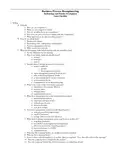
Business Process ReengineeringMethodology and Practice DevelopmentIssues ChecklistI. SellingA. Globally1. Who are our competitors?2. What are our competitors doing?3. How do we differ from our competitors?4. How does our price structure compare with the competition?5. What approach do we take in selling projects?B. How do we obtain leads?1. Business developer2. Networking with audit partners and managers3. Previous engagement referrals4. Other service line referralsC. What should happen at the initial meeting with the potential client?1. Set the objectives for the meeting2. Who from Arthur Andersen should attend?a. partner?b. manager?c. senior?3. Identify what is driving the need for the project?a. market conditions1. growth2. declining revenue streamb. upper management pushing down projectc. poor or declining financial resultsd. project management's desire to improvee. system enhancementsf. commitment to be on the leading edge4. What is the scope of the work being requested?a. departments of company affectedb. analysis phasec. redesign phased. implementation phase5. What does management see as the benefits of this project?a. streamlined proceduresb. improved customer servicec. reduced payroll costsd. better cycle timese. cash flow savings6. How does management intend to handle these benefits?a. reduced payroll through attritionb. layoff of personnelc. savings with no personnel reduction7. What kind of change management issues may be faced on this job?a. long-time employeesb. low-skilled versus highly-skilled employeesc. effects from previous consulting projectsd. legal restrictions (i.e. EEOC)e. company history7. Why does the company believe an outside consultant is needed?8. Who are the competing firms?9. Is our contact a decision maker or is another approval required? If so, then who delivers the message?10. Does the company have a budget for the project?11. Does the company believe the solution is process or technology driven?12. What criteria will the company use to select a consultant?13. What resources can the company bring to the table?a. full-time project leaderb. steering committee participantsc. other project team members14. What is the perceived timing of the project?15. Review the company's organization chart16. Obtain background information on the client for engagement acceptancea. is it an existing audit or tax client?b. what is the status of other Andersen fees, if any?c. what is the company's financial condition?d. what kind of experience has Andersen had with this company?17. Should a diagnostic be performed?D. Complete the Arthur Andersen engagement acceptance questionnaire, form AP-100E. Is a follow up meeting needed with the client?1. Is the company serious about hiring someone or is it shopping for ideas?2. Resolve new or unanswered questions3. Follow up on any additional research requirements4. Develop a specific timetable for work to be performeda. diagnosticb. proposalc. acceptance of proposald. engagement timetable5. Identify potential project leaders, steering committee and other client participants6. Develop the communication tools to the employees regarding the project or diagnostica. why is a project needed?b. what will result from this project?c. what is expected of the employees?d. who will be performing the work?F. Perform a diagnostic analysis of the company1. Which employees should be included in the diagnostic?2. What should be performed as part of the diagnostic?a. employee interviews1. how many?2. with whom?3. how long should they last?4. who should interview the people?5. what do we need to learn from the interviews?a. headachesb. process flowc. bottlenecksb. process flow chartc. review of data1. financial information2. headcount3. processing statistics3. Who should perform the diagnostic?a. partner?b. manager?c. senior?d. staff?4. What should be learned from the diagnostic?a. barriers to change or issues / problems we will need to overcomeb. basic process flowc. number of redundancies in tasksd. volume of reworke. approximate time spent resolving problemsf. excessive internal controls2g. potential savings1. what positions appear non-value added?2. what are the dollar savings associated with those positions?3. any non-payroll savings?4. leadtime compression opportunitiesh. estimate of time required to perform the projecti. number of interviews to conductj. number of processes & departments involvedk. systems or software tools currently utilized in the process(es)l. determine resource committments from the companyG. Develop a proposal1. Determine the proposal's structurea. what message needs to be delivered by the proposal?1. what are the deliverables?2. what is required of the company?b. who will be reviewing the proposal?c. who is making the yes/no decision?d. are the people familiar with other consulting projects or Arthur Andersen?e. is this a formal proposal or a letter?f. what are the contents of the proposal?1. summarya. what is the need for the project?2. why use Arthur Andersen?3. what are the issues & objectives?4. what are the benefits?5. what is the approach?6. what is the scope?7. what are the deliverables?8. who is the project team?9. timing & fees10. credentials2. Accumulate material for the proposala. complete pieces of the outline1. refer to previous proposals for examples2. incorporate information obtained from the diagnostic3. calculate the cost of the projecta. what is the scope of the project?b. project duration1. number of departments2. number of employees3. geography of locations; amount of travel4. how much planning is needed?5. what holidays or other time constraints exist?6. how many company personnel can be utilized?7. who will work on the engagement?c. should out-of-pocket expenses be incorporated in the analysis?d. over what timeframe will the company earn its benefits?1. time value of money2. payroll reductions3. higher sales dollars4. reduced costse. are the benefits an annuity or one-time savings?f. calculate a payback timelineb. compare the proposal to original structure for completeness3. Have material reviewed by appropriate levels of the project team4. Have material formally prepared in a presentation format3。
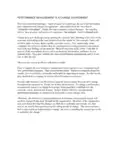
PERFORMANCE MEASUREMENT IN A CHANGE ENVIRONMENTNew environmental challenges - rapid advances in technology, the rise of global markets and competitors and changes in regulations - add complexity to the very idea of “competitive advantage”. Hence, the wa y companies conduct business - the way they deliver their products and services to customers - has changed. And it’s changed a lot. Facing these new challenges means putting the customer first, listening to the voice of the customer and looking at the total business from the outside in. For example, banks will set their sights on faster, higher quality, customer service. Yet, surprisingly, many companies do not know whether they are meeting and exceeding customer expectations. One of the key findings of our study on “Bank Productivity in the 1990s“ was that 25 percent of the respondents do not collect productivity information, and hence do not measure them. They don’t address the issue of performance measurement until it is too late or after-the-fact.There are two serious problems with that oversight:First, to support the new structures, management styles, and processes, companies need new performance measures. That’s just common sense. These new measures should be simple, close to activities, actionable and helpful in supporting strategies. In other words, they should help a company do a better job of focusing on customers.Second, right measures can, themselves, generate improvement; they can drive change throughout an organization. People act as they are measured. To change a performance measurement system is to change how people understand their contribution to the corporate vision, mission and strategy. In fact, without effective and appropriate performance measures, it’s pretty m uch impossible to make change stick.Obviously, this initiative of implementing new performance measurement system will result in changes being made throughout the organization. Members of the organization may sometimes find that the changes are difficult to undertake and sustain. For that reason, we need to have good reasons for asking people to change. The more resistance that is expected from implementing a change, the more compelling the reasons have to be to undertake the change.In order to motivate people to make a change that they may perceive as difficult, we need to establish burning platforms. An oil rig superintendent survived from a disastrous explosion occurred on an oil drilling platform because he took a potentially fatal leap to the water. When asked why, he said, “ It was either jump or fry.”He chose possible death over certain death. He jumped because he had no choice - the price of staying on the platform, of maintaining the status quo, was too high.[Please insert burning platform picture]An organizational burning platform exists when maintaining status quo becomes prohibitively expensive. Major change is often costly, but when the present course of action is even more expensive, a burning platform situation erupts.The key characteristics that distinguishes a burning platform situation from other situations is that when an organization is on a burning platform, the decision to make a major change is not just a good idea - it is a business imperative. A business imperative does not only result from an organization’s having to overcome an imminent interest. A business imperative can result from an organization’s wanting to seize an opportunity.Performance MeasuresAs vital signs, performance measures tell people what and how they’re doing as part of the whole. They communicate what’s important throughout an organization: strategy from top management down, process results from lower levels up, and control and improvement within processes.Yet, what exactly are performance measures? A performance measure is a quantification of how well activities within a process or the outputs of a process achieve a specified goal. Performance measures must be .....☑Simple to understand and use☑Close to operations☑Aligned with corporate strategy☑Promotes continuous improvementPerformance measurement is really a balancing act.First, there are two types of performance measures and these must be balanced. Process measures report the activities of a process and are used to motivate people and control the process. Output measures are the results of a process and are used to control resources and monitor results.The problem with most companies is that they have too many output measures (for example, financial ratios and variances, number of loans approved, number of delinquent accounts, etc.) and too few (if any) process measures (loan approval cycle time, number of application errors, number of skills, inquiry response time, etc.).Both types are necessary. Output measures keep score; but process measures drive improvement.In addition, there are three categories of measures and these, too, must be balanced:☑Quality (the “goodness” of a product or service as defined by the recipient - internal or external customer)☑Time (the “goodness” of a process as defined by the management, customer or another process)☑Cost (the economics of “goodness” as defined by the management and shareholders)By focusing attention simultaneously on Quality, Time and Cost, a company can optimize the results of its processes and of the whole organization. We call this optimization Quantum Performance: The level of achievement that optimizes the organization’s value and service to its stakeholders.Quantum Performance Measurement ModelWe have developed a Quantum Performance Measurement Model to help companies devise the right performance measures. This model provides a systematic, logical, coherent, and comprehensive approach to the development, implementation, the use of performance measures that help a company realize its vision, mission, and strategies.。
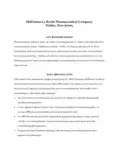
Hoffmann-La Roche Pharmaceutical Company,Nutley, New JerseyKEY BUSINESS ISSUESPharmaceutical companies today are under increasing pressure to reduce costs and respond to current medical reforms. Hoffmann-La Roche - Nutley, the largest subsidiary of it's Swiss-based parent, had conducted numerous cost-improvement projects at its New Jersey facilities, but costs kept climbing. Hoffmann-La Roche needed a performance measurement system for identifying process improvement opportunities and maintaining an environment of continuous improvement.HOW ABM WAS USEDWith much of the groundwork already completed by the ABM Champion, Hoffmann-La Roche asked Arthur Andersen to help set up a pilot ABM model. The objectives of the pilot were to train a team of employees to implement the process and demonstrate the benefits of the methodology to other parts of the company.∙The 15-member cross-functional team consisted of employees with both financial and operational backgrounds.∙ A new approach labeled "Just In Time" training was utilized to brief team members on various ABM phases immediately prior to performing the tasks.∙An ABM Bulletin Board kept the organization apprised of the project's status and how activities were being defined. It kept communications open and helped speed theinformation-gathering process.∙Frequent Steering Committee meetings with top management maintained executive support and enthusiasm.HOFFMANN-LA ROCHE'S RESULTSUpon completion of the eight week pilot project the team established a solid base of ABM expertise. Now, leveraging off that base, the company is rolling out the process to other parts of the Nutley, New Jersey, facility.∙Responsibility for implementing improvement opportunities identified during the pilot have been assigned∙Full implementation teams and plans have been established for the remainder of the functional areas included in the pilot and two additional function∙An ABM integration team has been formed to automate data collection and model updates.Product costs have generally been secondary concerns for pharmaceutical companies, where researchers dedicated to improving human health are primarily preoccupied with the benefits emanating from a steady parade of wonder drugs. Not anymore, though. With today's intense focus on medical reforms and cost reductions, drug manufacturers are turning every page looking for new opportunities to lower costs and still maintain their superior quality standards.Hoffmann-La Roche Pharmaceutical Company is no exception. This leading manufacturer, headquartered in Basel, Switzerland, has operations in that country, in the United States, and in Puerto Rico. One of its premier facilities in Nutley, New Jersey, about 10 miles from New York City, was caught in pharmaceutical’s cost-reform tidal wave and has been seeking alternatives to meet demands for lower-prices.Cost ImprovementFor several years, the company tried various cost-reduction and profit improvement programs. "These projects always appeared to be successful," reported the project's sponsor "Yet, every month when we looked at our actual financial data, our costs continued to climb." Laying offemployees may have a bottom line impact, he added, but that was not the answer to the long-term savings the company needed.The need, as far as Hoffmann-La Roche was concerned, was to put a process in place that would enable the company to first identify critical areas for improvement and then measure precisely what benefits they achieved. The company identified Activity Based Management (ABM) as the process for continuous bottom line impact and improvement.Doing the Spade WorkBob Fischetta, Hoffmann-La Roche's Assistant Controller and Director of Technical Services, served as the project champion and did the spade work for ABM. His knowledge of the methodology enabled him to communicate to the company's senior management the many benefits of ABM. Mr. Fischetta held numerous presentations and training sessions preaching the advantages of ABM. Lou Schmukler, Director of Pharmaceutical Operations, quickly joined the chorus and kept the resources for the project focused and moving in the right direction, forward. It was this blend of both financial and operational executive support that laid the foundation for a successful project. When Hoffmann-La Roche called in Arthur Andersen consultants to help set up the initial ABM pilot project, the company had full executive support and a 15-member cross-functional team already in place to begin the engagement."It was an ideal situation from the beginning," reports the Arthur Andersen project manager. "We had everything we needed to launch the pilot project: executive support, experienced resources and an appetite for change".Everyone involved in the project expressed the same desire for better process information and all saw ABM as the answer. The team was comprised of two members with financial backgrounds with the remainder from operations. Three team members served as the core。
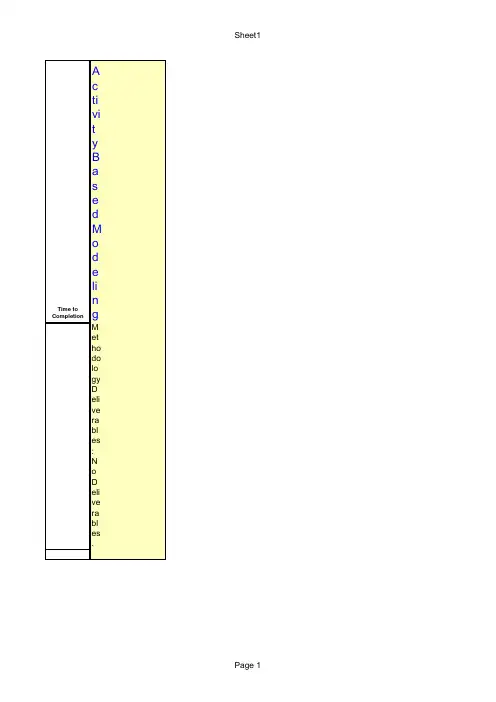
Comm. Industry Performance Meas.Methodology Deliverables: No Deliverables.Phase Name: IdentifyingPhase Deliverables:QP 1 Deliverable ListStep Name: Project PlanningStep Deliverables: No Deliverables.Tasks:1. Obtain mission statement, strategies, orgcharts, job responsibilities.2. Review environmental information (customer satisfaction, employee satisfaction, regulatory,competitive position).3. Understand current way of doing business (evaluations process, bonus structure, promotions).4. Prepare project management documentation - budget, WinSmart, etc.5. Develop project work plan, schedule and milestonesStep Name: Articulate Strategy and ID goalsStep Deliverables:Strategy, Goals and Performance Measures MatrixTasks:1. Identify required attendees2. Send out notification, prereads on performance measures and balanced scorecard, set expectationsfor time and effort involved in this meeting.a. Bring in facilitatorb. Have meeting with senior management to determine strategic intent for the next 5-10 years.i. Compare the verbalized strategies with written and resolve discrepanciesii. For each strategy, identify its goal (KPI)iii. Ensure goals are across all dimensions of the balanced scorecard or QCTiv. Quantify targets for each goal for the next yearv. Assess Resource constraints to meet all goals as quantified.vi. Prioritize the strategies3. Hold debrief meeting. Hold informal discussions with different levels of management todetermine if the prioritization of strategies is consistent with current business approach.4. Hold second meeting with senior management to discuss strategies - goals - organizationalperformance measures.Step Name: Determine Organizational. Performance MeasuresStep Deliverables:Strategy, Goals and Performance Measures MatrixTasks:1. Meet with senior management of the organizational unit to develop the strategies - goals -organizational performance measures. (This possibly can be combined with the meeting in task1.2.4.)Step Name: Map Strategies, Goals and Supporting ProcessesStep Deliverables:Strategy, Goals and Performance Measures MatrixTasks:1. Perform an initial analysis of processes.a. Develop block diagrams of the primary processes of the organizationb. Determine the primary function units within the processc. Identify primary inputs/outputs of the processes2. Finalize the matrix of strategies, goals, organizational performance measures and supportingprocessesStep Name: Develop Process Performance MeasuresStep Deliverables:Strategy, Goals and Performance Measures MatrixTasks:1. Verify the major functions included in ea. process (in order to determine if key functionalmanagers should be included in the process facilitation sessions and to determine the in-processmeasures required)2. Send an outline of the performance measurement identification process and the matrix of strategies- goals - organizational measures - supporting processes to the process owners.3. Conduct the process facilitation session. Keep the number of participants below 15 for maximumeffectiveness. As part of the session:a. Determine the process level strategies which support the overall organizational strategies.b. Identify the performance measure which would measure the output of the process (use thefour dimensions of the balanced scorecard or QCT)c. Identify the key internal process hand-offs which are critical to achieving the overall processoutput.d. For each hand-off from c. above, identify the relevant internal performance measures.4. Add new measures to the Matrix of Performance Measures5. Meet with the process owners, process customers and organization senior management to finalizeand obtain buy-in for the process measuresStep Name: Develop People Performance MeasuresStep Deliverables:Strategy, Goals and Performance Measures MatrixTasks:1. Gain an understanding of work content, skill requirements and job outputs2. Review current performance measures and any contract/union restrictions3. Bring together groups of job incumbents and 1/2 managersa. Review the process to dateb. Review the process strategies and measuresc. Discuss the required individual job accomplishmentsd. Brainstorm the performance measures to meet the accomplishmentse. Review the potential measures against adequacy criteria.4. Consolidate the output of the meeting5. Separately, assess the performance measures v. the process/organ. measuresStep Name: Map and Filter Measures and StrategiesStep Deliverables:Strategy, Goals and Performance Measures MatrixTasks:1. Complete the performance measures matrix for all of the strategies identified.2. Review all of the performance measures using the Filtering/Target Setting Tool.3. For any of the measures which do not meet the criteria, take them out of the overall potentialmeasures4. Review the reasonableness of targets based upon historical and benchmark information5. Understand the interrelationship of measures at each level. Ensure that measures are balancedand not “skewed” toward one strategy.Step Name: Communicate and Obtain ConsensusStep Deliverables: No Deliverables.Tasks:1. Prepare a communications matrix of impacted work groups2 Hold focus group meetings with impacted groups3. Assess feedback and incorporate into performance measuresStep Name: Obtain Management Sign-offsStep Deliverables:Strategy, Goals and Performance Measures MatrixTasks: No Tasks.Step Name: Quality AssuranceStep Deliverables:QA Memo。